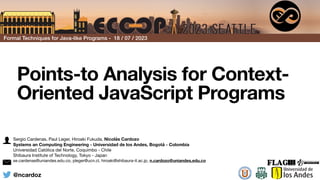The document presents a points-to analysis for context-oriented JavaScript programs, detailing the implementation of various functions and examples illustrating the complexity of dynamic programming requirements. It discusses context-oriented programming (COP) concepts and methods for analyzing and adapting code using traits and behaviors, ultimately focusing on dynamic modularity in programming. Experiments conducted compare different approaches for evaluating precision and how effectively COP can manage complex changes in code execution.






























![Context identification and transformation
11
Encryption.adapt(Msg, EncryptionBehavior);
Encryption.activate();
Encryption = new cop.Context({});
EncryptionBehavior = Trait({
send: function(msg) {
return "<E>" + this.proceed() + "<E>";
}
});
for(var p in
Encryption.adaptation1.trait.obj) {
(function (prop) {
Encryption.adaptation1.obj[prop] =
Encryption.adaptation1.trait.obj[prop];
})(p);
}](https://image.slidesharecdn.com/ftfjp23-230718181901-2034b9e0/85/FTfJP23-Points-to-Analysis-for-Context-oriented-Javascript-Programs-31-320.jpg)













